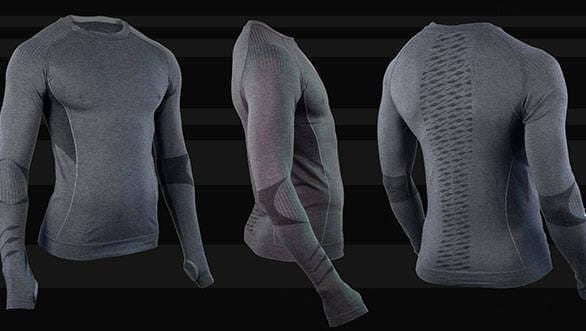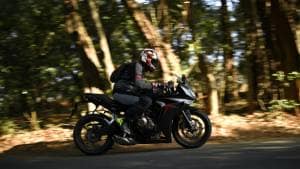Riding gear: Baselayers change everything
A few years ago, I broke down all the components of motorcycle riding gear into the whats, whys and how muchs of procuring and using protective equipment. The joke at the time was that I had not written about underwear. Well, it's about damn time, eh?
 Image source: Showers Pass
Image source: Showers Pass
Next to skin
If you read about the humans operating under varying or troublesome conditions, you should quickly see a pattern. That our bodies shiver and sweat to maintain our core temperature at a level which allows us to function. Even a relatively minor impairment of this ability is very stressful to the human body. And a major impairment can cause severe issues like hypothermia or heat stroke.
The other thing worth noting is that role of what you're wearing and the huge role what is next to your skin plays in how you feel about the weather you are in. In outdoor gear terms, this layer of clothing is called the baselayer.
Ubiquitous cotton
In India, our weather is largely warm, and we have been told from the very start that we should tend towards cotton as a response to this. This is not bad advice. But this hinges on the idea that the cotton is the only layer. Or that you will wear perhaps two layers and both will be cotton. Cotton absorbs sweat easily and air can get through it, which is useful in warm weather.
But cotton is a terrible material when it comes to dealing with abrasion and tension (stretching). In a motorcycle accident, we need the outer layer to be able to prevent the friction with the ground as you slide along from tearing through the fabric and exposing your skin. Cotton is laughably bad at this. Which is why denims, for example, make terrible riding pants to have on when you have a crash.
So usually, you will wear an outer layer made up of a synthetic material that is good with abrasion and tension. Like Cordura, heavy-gauge nylon etc. These, however, prevent cotton from doing its normal absorbent-breathable job. So the cotton tee you wear absorbs your sweat, but since the wind supply to it is compromised, it finds it difficult to get the sweat to evaporate away. And worse, cotton absorbs water and becomes heavy and flabby which feels terrible.
As you can imagine, I'm about to tell you that you should be eliminating cotton from your base layer material palette. It simply doesn't work.
Wicking hour
What you should be using instead are clothes made from "wicking" materials. The word wicking implies that the fabric absorbs a staggering amount of water very rapidly but spreads the wetness over a very large area. This mitigates that soaked/soggy/wet feeling while promoting rapid evaporation. The rapid evaporation produces a cooling effect which, in turn, reduces the need to sweat. Wicking materials tend to be synthetics, polypropylene is common. Merino wool is considered the most excellent of the natural wicking materials.
What you should be looking for is a snug-fitting top and bottoms to wear under the motorcycle gear. The snug fit is essential because wicking baselayers are usually made from extremely thin materials. The skin contact is essential to their performance. And if they're the right fit, you won't even feel like you are wearing a baselayer once riding - it sounds odd but feels wonderful.
Other advantages
The availability of a good baselayer next to skin also seems to expand your ability to withstand temperatures both higher and lower than normal. It's hard to explain but you'll feel cooler in warm weather as well as warmer in cold weather. And of course, you get both cold- and warm-rated baselayers designed to extend their ability - and your performance - in extra-warm or cold conditions.
Second, you never feel sticky and soggy. I've found that riding in warm weather, in the rain with even the best, breathable membrane-style waterproofs will cause fairly heavy sweating. But wearing a baselayer instead of cotton seems to at least eliminate the feeling of being soaked in sweat on the inside from this process. You will 'discover' the sweat at the end of the ride about five minutes before you step into the shower.
Third, baselayers tend to dry superfast. This means even when you get soaked, the layer next to your skin works extra hard at drying up. You will not be wet for long.
Baselayers also have significant logistics advantages. They usually pack to remarkably small volumes, much, much smaller than the same size cotton T-shirts. You can also wash them in the night and expect to have them dry out and smell fresh in the morning under almost all conditions too. And they're much lighter per square inch than cotton as a rule.
Disadvantages
There are a few. First, because they are thin, baselayers exposed to high friction, like the area on the inside of the knee or the area ahead of the elbow on the forearm can wear out fast.
Second, heavily used baselayers can pick up a slightly vinegar-y smell that you will notice when you put it on.
Third, baselayers are rarely cheap.
The most surprising negative is the combination of a baselayer, mesh and rain. If you ride in the rain and get soaked while wearing a mesh jacket over a baselayer, prepare to freeze. You will feel unbelievably cold, I promise.
Other considerations
If you're going to use a baselayer, do not wear a cotton T-shirt on top, or a pair of cotton briefs or boxers under the bottom. That defeats their purpose, they have to be on skin to work.
When you're buying baselayers, especially in India, you're likely to end up finding leggings designed for activities like running - stuff that you do standing up.
On a motorcycle, the baselayer should be seam-free in the butt area so you don't sit on a seam. Seams will eventually hurt, and I find that the butt ache is postponed about three-four hours on the average ride if you can avoid seams.
If you're not of an athletic build, you will have to get over any body image issues. At the average rest stop, the baselayer is a pretty unforgiving garment in terms of what it reveals of your body shape. It is why motorcyclists the world over are famous for being clad in skin-tight clothes at coffee stops.
Final suggestions
Baselayers are ride-altering but they are also expensive. My suggestion is to buy just one top, like a Nike Dri-Fit or something and giving it a go. Spending Rs 1,500 to 2,000 on a thing and light tee seems extravagant, but I suspect that it will reveal to you a world of comfort in the face of every riding condition that you never imagined. And soon, you'll find a drawer full of them in your cupboard. And yourself at a rest stop far from home with your gut hanging out, completely ignoring the ambient heat/cold. Don't ask how I know.
What do I wear?
Japanese clothes brand Uni-Qlo is my go-to baselayer brand. They have two lines, Airism for the summer and HeatTech for the winter - both of which are remarkable. I use Airism for 90 per cent of my riding, including on cold days in Ladakh, and find the comfort levels sky high. Prices for V- and round-neck half-sleeve Airism tees range from $8 (season discounts) to $15 (list prices). HeatTech is slightly thicker material, surprisingly warm and on average $3 to $7 more per garment.
Unfortunately, Uni-Qlo doesn't make fitted Airism bottoms. So I use RS Taichi's warm weather riding baselayers (Rs 1,500 odd). I also bought a brand called Tesla ($8 per bottom, amazon.com), which was the cheapest pair of compression baselayer bottoms I could find on amazon - cheap and serviceable.












